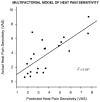Psychological and sensory predictors of experimental thermal pain: a multifactorial model
- PMID: 20570569
- PMCID: PMC2954262
- DOI: 10.1016/j.jpain.2010.03.014
Psychological and sensory predictors of experimental thermal pain: a multifactorial model
Abstract
Although large interindividual differences in pain exist, the underlying factors that contribute to these variations remain poorly understood. Consequently, being able to accurately explain variability in pain ratings in terms of its contributing factors could provide insights into developing a better understanding of individual differences in pain experience. In the present investigation, we show that a significant portion of the variability in experimental heat pain ratings may be predicted using simple quantitative sensory testing and a series of psychological questionnaires including State Trait and Anxiety Inventory (STAI), Center for Epidemiologic Studies - Depression Scale (CES-D), and Positive and Negative Affect Schedule - Expanded form (PANAS-X). A factor analysis was used to reduce individual predictors into sets of composite predictive factors. A multifactorial model that was generated from these factors can reliably predict a significant amount of the variability in heat pain sensitivity ratings (r² = .537, P = .027). Moreover, individual variables including heat pain thresholds and self-assessment of pain sensitivity were found to be poor predictors of heat pain sensitivity. Taken together, these results suggest that a variety of factors underlie individual differences in pain experience and that a reliable model for predicting pain should be constructed from a combination of these factors.
Perspective: The present study provides a way to predict subjects' experimental heat pain sensitivity using a multifactorial model generated from a combination of sensory and psychological factors. Future application of such a model in the studies of clinical pain could potentially improve the quality of care provided for patients in pain.
Copyright © 2010 American Pain Society. Published by Elsevier Inc. All rights reserved.
Figures

Similar articles
-
Suprathreshold heat pain response is associated with clinical pain intensity for patients with shoulder pain.J Pain. 2011 Jan;12(1):133-40. doi: 10.1016/j.jpain.2010.06.002. Epub 2010 Aug 7. J Pain. 2011. PMID: 20692209 Free PMC article.
-
Mechanical and heat hyperalgesia highly predict clinical pain intensity in patients with chronic musculoskeletal pain syndromes.J Pain. 2012 Aug;13(8):725-35. doi: 10.1016/j.jpain.2012.04.006. Epub 2012 Jun 26. J Pain. 2012. PMID: 22739051 Free PMC article.
-
Pain catastrophizing is associated with pain thresholds for heat, cold and pressure in women with chronic pelvic pain.Scand J Pain. 2020 Jul 28;20(3):635-646. doi: 10.1515/sjpain-2020-0015. Scand J Pain. 2020. PMID: 32383692
-
Is heat pain detection threshold associated with the area of secondary hyperalgesia following brief thermal sensitization? A study of healthy volunteers - design and detailed plan of analysis.BMC Anesthesiol. 2016 May 31;16(1):28. doi: 10.1186/s12871-016-0193-2. BMC Anesthesiol. 2016. PMID: 27246322 Free PMC article. Clinical Trial.
-
Alexithymia in fibromyalgia syndrome: associations with ongoing pain, experimental pain sensitivity and illness behavior.J Psychosom Res. 2009 May;66(5):425-33. doi: 10.1016/j.jpsychores.2008.11.009. Epub 2009 Jan 16. J Psychosom Res. 2009. PMID: 19379959
Cited by
-
AMAZONE: prevention of persistent pain after breast cancer treatment by online cognitive behavioral therapy-study protocol of a randomized controlled multicenter trial.Trials. 2022 Jul 25;23(1):595. doi: 10.1186/s13063-022-06549-6. Trials. 2022. PMID: 35879728 Free PMC article.
-
Individual differences in the subjective experience of pain: new insights into mechanisms and models.Headache. 2010 Oct;50(9):1531-5. doi: 10.1111/j.1526-4610.2010.01763.x. Headache. 2010. PMID: 20958300 Free PMC article.
-
Pain sensitivity is inversely related to regional grey matter density in the brain.Pain. 2014 Mar;155(3):566-573. doi: 10.1016/j.pain.2013.12.004. Epub 2013 Dec 11. Pain. 2014. PMID: 24333778 Free PMC article.
-
Challenges with Assessing and Treating Pain in Research Primates: A Focused Survey and Literature Review.Animals (Basel). 2022 Sep 5;12(17):2304. doi: 10.3390/ani12172304. Animals (Basel). 2022. PMID: 36078024 Free PMC article. Review.
-
Deficits in temporal pain inhibition are associated with greater pain and functional impairment in osteoarthritis.Pain. 2025 Jun 19:10.1097/j.pain.0000000000003648. doi: 10.1097/j.pain.0000000000003648. Online ahead of print. Pain. 2025. PMID: 40539481
References
-
- Alschuler KN, Theisen-Goodvich ME, Haig AJ, Geisser ME. A comparison of the relationship between depression, perceived disability, and physical performance in persons with chronic pain. Eur J Pain. 2008;12:757–64. - PubMed
-
- Auerbach SM, Laskin DM, Frantsve LM, Orr T. Depression, pain, exposure to stressful life events, and long-term outcomes in temporomandibular disorder patients. J Oral Maxillofac Surg. 2001;59:628–33. discussion 634. - PubMed
-
- Bar KJ, Brehm S, Boettger MK, Boettger S, Wagner G, Sauer H. Pain perception in major depression depends on pain modality. Pain. 2005;117:97–103. - PubMed
-
- Benrud-Larson LM, Wegener ST. Chronic pain in neurorehabilitation populations: Prevalence, severity and impact. NeuroRehabilitation. 2000;14:127–137. - PubMed
-
- Bini G, Cruccu G, Hagbarth KE, Schady W, Torebjork E. Analgesic effect of vibration and cooling on pain induced by intraneural electrical stimulation. Pain. 1984;18:239–48. - PubMed
Publication types
MeSH terms
Grants and funding
LinkOut - more resources
Full Text Sources

